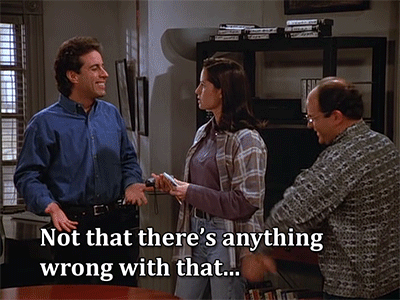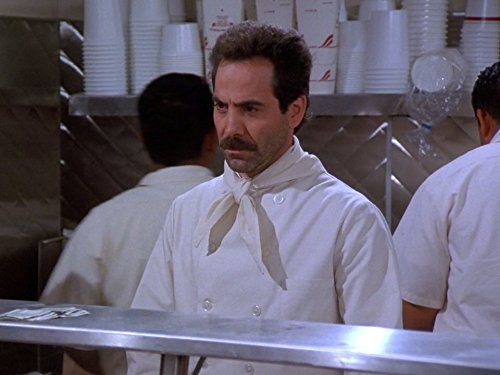The season of Festivus is upon us, and I have some grievances to air with the same YouTube channel that tried to trademark the word “Reacts.” Fine Bros. Entertainment has launched a new series called “Does It Hold Up?” which is designed to look at older media and examines whether or not it still resonates with a younger generation. The first, and so far only media they’ve examined is Seinfeld, which I actually think is due for a reexamination.
Seinfeld turns 30 next year, and only ended in 1998. In the grand scheme of things, that’s really not that old. It ended only five years before Arrested Development started, and only seven years after both The Office and It’s Always Sunny in Philadelphia began. But in terms of setting, it does feel rather dated. In one episode, Jerry says “What the hell is email?” which is played as a joke, because naturally email was still young. In the last episode of the show, Jerry and George tell Elaine that calling her friend on a cell phone is a social faux-pas.
Culturally, it seems so long ago. Star Wars hadn’t even had its prequels at that point, now we’re onto its sequels. Donald Trump wasn’t even a reality television star at that point. How can a situational comedy so far removed from our experience still ring true? And I think that’d be a question worth examining. Fine Bros. Entertainment, on the other hand, seems to only be interested in one aspect of how Seinfeld holds up:
Now, at 24 years old, I’m not that much older than some of the people in this video (notably within the 18-29 year old demographic specified). I definitely don’t want to be the kind of person who grumbles about how FBE and the people reacting in this video are being “too PC,” but Seinfeld is presented in this video in a way that deliberately highlights the characters are at their worst, and the teenagers/college students accept this as though its the great moral lesson of the show.
One issue with this “Does it Hold Up?” Series that FBE is trying to launch is that (at least in this first episode) they can seem to decide by what measure it holds up. Are the people reacting to the video solely based on how funny it is/how the humor resonates with a modern viewer? Or should they examine how our societal values now are different from back then? Frankly, I think one question’s more interesting than the other; if you put any piece of media in a time capsule for 20-30 years, it’s almost certainly going to be less acceptable. But the way comedy deteriorates over time is a much more dynamic question with a much less obvious answer. Why does Shakespeare’s Much Ado About Nothing make me laugh more than Charlie Chaplin movies – were people in the 1600’s inherently funnier than people in the early 20th century? These questions intrigue me.
Instead, primary concern of “Does It Hold Up?” seems to be showing the teenagers/college students clips from Seinfeld – apparently, not entire episodes, but instead, carefully edited clips. – and having them imagine what the twitter reaction would be if the episodes aired today.
(Let me say upfront that my dislike of this video comes from the way the clips from Seinfeld were selected and the way that Fine Bros. Enterainment [FBE] edits the reactions to create an overarching narrative of “Seinfeld is morally bad.” My issue is not necessarily with the people reacting to the clips.)
The thing is, they all seem to miss an important point about Seinfeld. There’s a great deal of comeuppance, including but not limited to the series finale, in which all four members of the main cast go go prison pretty much exclusively on character references. Even consider the episodes examined in which Jerry is said to be problematic – one in which he drugs (by giving her drowsy instead of non-drowsy medication) a woman to play with her toy collection and another in which he pokes fun at a Native American. Do you know how these episodes end? Neither ends well for Jerry.
In the episode “The Merv Griffin Show,” Jerry is brought to Kramer’s television set and publicly remonstrated by the woman he drugged, who then breaks up with him. Now, those aren’t exactly lasting consequences but it is a minor victory. The gang doesn’t face lasting consequences until “The Finale.”
Previously on this blog, I wrote about how the series finale (spoilers) ends with the four main characters going to prison for generally being bad people. This helps the show to wrap up with the point that these are not good people, and that’s something to consider when watching the show.

The people reacting to this episode are so astonished that this kind of thing was on television in the 1990’s. “It’s hilarious that people thought this was okay,” says one of the teenagers reacting to the clip. Well, if you watch the entire episode, it’s quite apparent that this wasn’t okay.
Another episode they show the group of teenagers/college students is “The Cigar Store Indian,” In which Jerry gets a wooden statue of a Native American and gives it to Elaine, much to the embarrassment of her Native American friend, whom Jerry is romantically interested in. Again, the reaction group seems to think that the episode is racist, rather than showing a racist character.
The issue is more with how the video intentionally leaves out the scenes in which Jerry gets his comeuppance. They barely show Native American Winona leaving him and they don’t show his embarrassment on Kramer’s television set because it doesn’t fit in with the narrative they’re trying to tell – that millenials are “too woke” for Seinfeld.
One of the people reacting in the video begins to understand it when reacting to “The Cigar Store Indian” episode, when she says “I think this episode holds up, as the audience member we can see that they’re obviously in the wrong through other characters that call them out.” But that person doesn’t even have that same outlook throughout the video. All of the reaction audiences have a hard time of putting these episodes in their proper contexts.

And then they were shown clips from the episode “The Outing,” in which a reporter writes an article claiming that Jerry and George are gay together, leading to the repeated refrain “We’re not gay! Not that there’s anything wrong with that!”
One of the reaction audience found this to be the most egregious episode of television ever; “I am so fucking pissed,” she says while watching it. Flabbergasted, she adds, “Even if I wasn’t gay and that didn’t directly apply to me, I actually do have gay friends and I would be like upset for them!” When asked to evaluate if this specific episode holds up she says angrily “NO! That’s so weird to me, like why would that be your thought pr- like oh let’s pull a prank on them like oh let’s pretend you guys are a gay couple like how is that funny?” According to this viewer, just because people twenty years ago reacted differently to a scenario that was vastly different at that time, this episode does not hold up. And I think that this perspective is rather short-term, and completely forgets the context of being gay in the 1990’s.
In the above video, “Seinfeld Confronts a Fear About Nothing,” Matt Baume gives the context that is missing for people who watch the episode today. He highlights the homophobia of the early 90’s and how shows like Seinfeld contributed to its decrease. On the show’s frequent refrain, Baume says:
“Not that there’s anything wrong with that.”
There’s just one problem. There obviously is something wrong with that, at least to the characters on the show. Every single suggestion that they might be gay is met with wild-eyed gay panic.
In 1993, homophobic gay panic freakouts were the norm, and far worse than Jerry and George’s. This episode put these freakouts under a microscope and revealed over and over and over that they are as stupid as fighting over a Junior mint or a Pez Dispenser.
This episode is able to break homophobia by mocking its ridiculousness.
I expect FBE did nothing to remind the teenagers and college students in the reaction group of the historical context of the 90’s, and perhaps expecting all of them to know it on their own – even the ones who are LGBT – might be a bit much. Though, to the groups credit, one viewer astutely notes: “For its time, I’m sure that for sure pushed it. They’re like ‘whoa, they’re talking about… *Whispers* they’re talking about the gays on TV!'”
Lastly, the example from the FBE video which is probably the most minute but also the least significant is when they watch “The Soup Nazi,” and a few of the viewers take issue with the word “Nazi.” One says, (perhaps as a joke,) “Can’t be throwing that word around!” and another scoffs, “I thought this [episode] was insane, how many times they say the word ‘Nazi.'” A third objects, “So he’s a Nazi just cause he yells?” And I feel like this might be cause of the awkward nature of the Fine Brother’s REACT™ videos – the people reacting likely always feel the need to be saying something in the hopes that some of what they say will be witty and will make for good Fine Bros. REACT™ content. There is a distinct possibility that this was a case of the viewers saying something just to say anything, and that they don’t acutally take issue with the word “Nazi,” but who am I to say? For thought, I’ll leave this quote from Albus Dumbledore – “Fear of a name increases fear of a thing itself.”

Politically, I’ve leaned left in more than a handful of posts on this blog before, but I feel as though fearing the word “nazi” is just a little too politically correct.
Again, I want to reiterate, my issue isn’t with the young adults in this video. Their hearts are definitely in the right place, and I can’t blame them for the show not directly aligning with their sensibilities. The issue I have is with the Fine Brothers, who are clearly framing this series in such a way that is either aggressively trying to condemn the show in an attempt to seem, for lack of a better word, “woke,” or perhaps just trying to condemn it to get views – which, to be fair, I’m talking about it.
I first started watching Seinfeld when I was in middle school because my parents liked it. This show has been a part of my life for an extraordinarily long time, and I’ve come to know it well. And one thing that I know to be true, especially given the nature of the series finale is that across all these episodes, I just think there’s one thing that viewers just need to remember:
The character Jerry is not supposed to be taken seriously. The show is not supposed to be taken seriously. The character Jerry does some pretty despicable stuff during the course of the show – that does not mean the creators of the show (real life Jerry Seinfeld included) endorse these things.
The characters in the show are in their own ways sexist, racist, homophobic, and generally reprehensible. But that does not necessarily mean that the show as a whole is. To borrow from Matt Baume’s video above: by mocking these behaviors and the people behind them, the show makes its message clear. But, the ever-righteous, frequently-viewed, trademark-seeking Fine Bros. Entertainment wants to build a narrative that Seinfeld – the show – is sexist, racist, homophobic, and reprehensible.
Hoo boy, wait till they hear about Its Always Sunny In Philadelphia.
Let’s end with some questions:
What’s your favorite television show that might not hold up with a modern audience?
Should comedy from another time period be considered in a modern context, or its own context?
Do you have a favorite episode of Seinfeld?
As always, thanks for reading


Great post, thanks
LikeLiked by 1 person